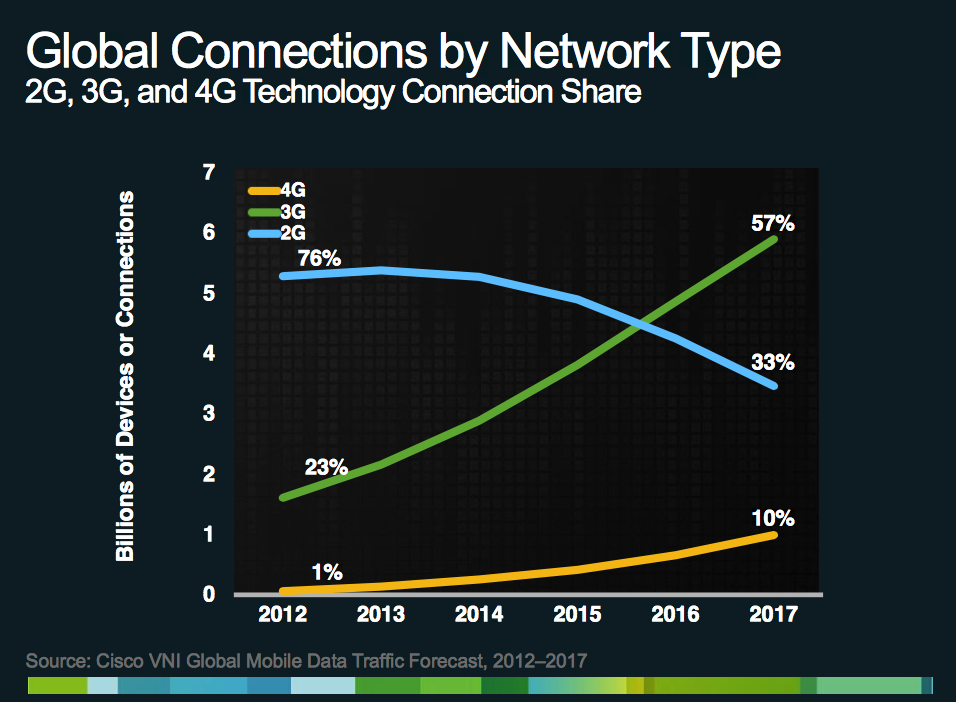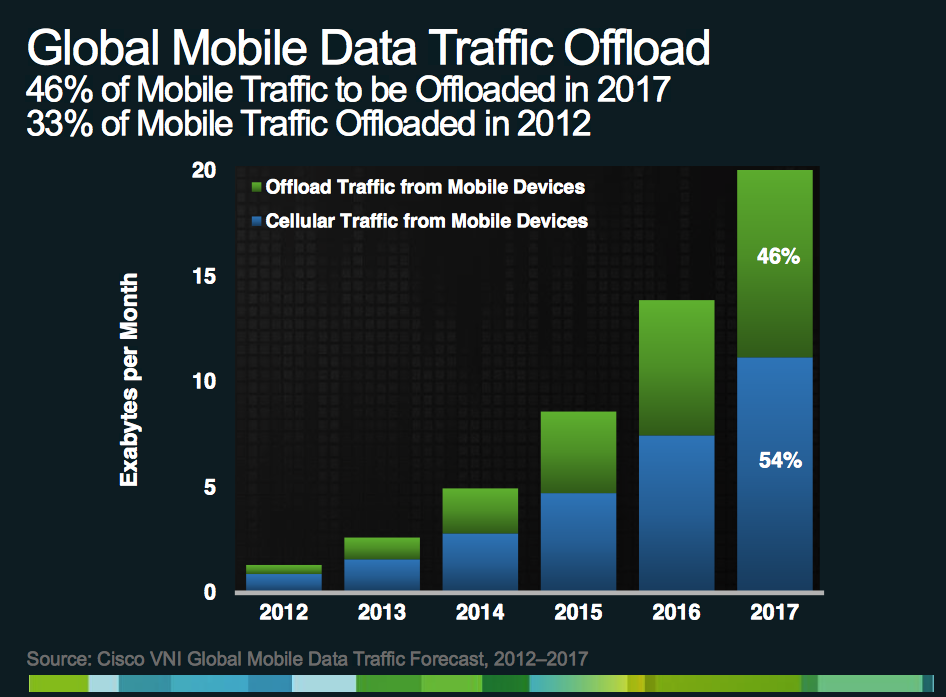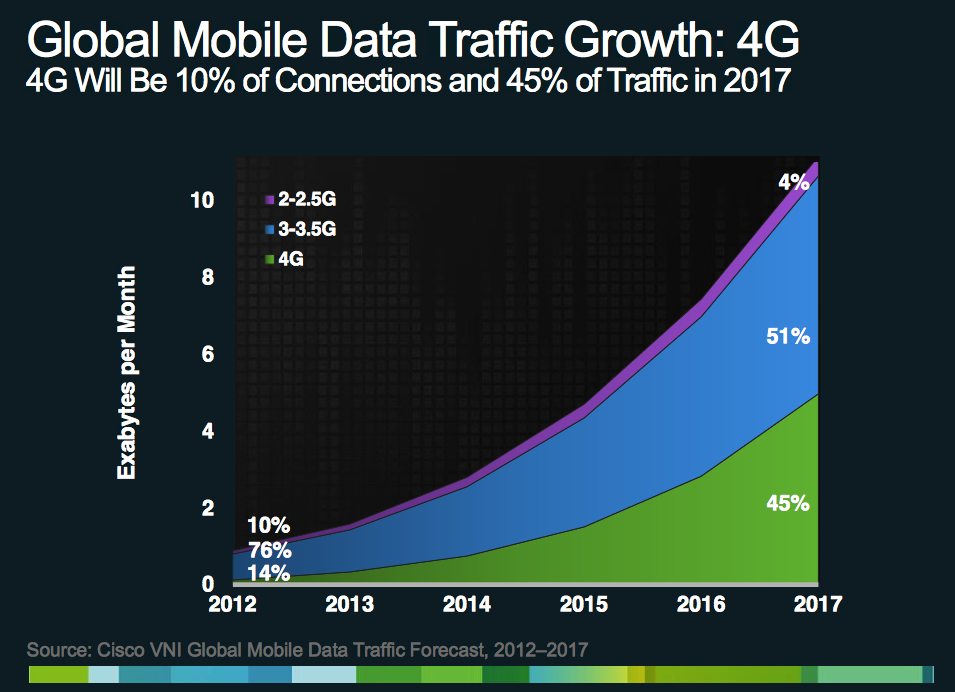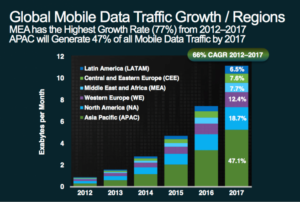Get ready for a new set of metrics as billions and yes trillions of petabytes of data stream through the world’s mobile networks delivering a surging volume of video content that will grow to a whopping 72% of the world’s mobile data traffic by 2019, according to new numbers from Cisco. The company is tracking the data in its Visual Network Index (VNI) that also seeks to “…forecast the impact of visual networking applications on global networks”. Its recent numbers, published this week, include a Mobile Data Traffic Forecast both regionally and globally, painting a picture that’s moving the needle of traffic volume, full orders of magnitude out from more traditional gigabytes, terabytes and petabytes. We are now in the more exotic exebyte, zettabyte and yottabyte realm, the latter representing a staggering one thousand trillion gigabytes or the equivalent data volume of 250 trillion DVDs. Cisco reckons that it takes 20 of these yotabytes of data to render a holographic snapshot of the entire earth’s surface.
Overall, its growth is forecast at a whopping 57% CAGR over the next five years according to the report, which looks at mobile data traffic over cellular networks (2G, 3G and 4G) without Wi-Fi. Cisco said that’s up to three times faster growth than than fixed IP traffic (that DOES include Wi-Fi) in the same period, from 2014 to 2019.
Wi-Fi is covered in Cisco’s comprehensive VNI report, that includes fixed networks and even breaks out dual mode devices (like smartphones and some tablets) reporting mobile offload numbers. Here users switch from cell networks to Wi-Fi as in the case of going to a Hot Spot hosted by say, Starbucks or McDonalds. For example, Cisco reckons that over half (54%) of global mobile data traffic (cellular) will be offloaded to Wi-Fi or small cell networks by 2019. That’s an 8% boost from 2014 global numbers that hit 46% last year.
Speaking of connections, today 3G and 3.5G account for up to 60% of mobile data traffic. 4G will grow to over one-quarter of total wireless connections by 2019 (26%) but handling almost 70% of the data traffic (68%). Cisco said that the growing number of smartphones using 4G today is driving the adoption and use of high speed applications that help push that data traffic number upward. For example, today a 4G connection generates 10X more traffic than previous standards. That number should drop to about 5X by 2019. Connection speeds too will grow, from a 1.7Mbps base line in 2014 to 4Mbps by 2019, according to the VNI numbers.
2014 global growth in the mobile space hit 69% YoY to 2.43 exebytes (or billion Gb.) per month and will reach 292 exebytes that year. The highest mobile data traffic growth rates were recorded in the less developed regions where build out is occurring at a rapid pace.
Here is the 2014 Global Mobile Data Traffic regional breakdown for 2014:
- 107% Middle East and Africa
- 91% Central and Eastern EU
- 87% Latin America
- 69% Asia Pacific
- 63% N. America
- 45% W. Europe
Video data was 55% of mobile network traffic in 2014 and is set to grow to almost three-quarters of all mobile traffic by the end of the study period in 2019. Moving pictures will become the dominant standard data format consumed by global mobile users (by volume).
Finally, don’t be fooled by a lower growth rate (CAGR), as we move toward the next decade. While the 2019 CAGR drops to 50% from last year’s high of 69% that incremental growth number forecast by the end of the decade (8.2 exebytes/mo) is 3X the entire mobile internet traffic experienced last year.
So as the number of mobile connected devices (including machine to machine) now exceeds the world’s population (at 1.5 per capita or 11.5B to the earth’s 7.6B people) get ready for a new lexicon to help track those tiny bits and bytes that combine together in a big way to deliver mostly video to mobile devices worldwide. The numbers have now grown to eclipse even the US  National Debt, and that’s saying something. – Steve Sechrist
National Debt, and that’s saying something. – Steve Sechrist



